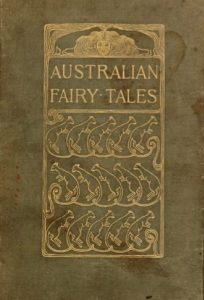Golden Cloud: A Christmas Story for Young People
Welcome to the Colonial Fiction website.
Over a century after its publication, what can a nineteenth-century colonial fairy tale reveal about settler identity and culture?
Nineteenth century children’s fiction operates as a space of literary colonisation. Literature directed at a young readership is often telling of the values represented in adult constructions of reality. In the context of the British settler colonies, imperialist ideologies relating to class structures, gender stereotypes and labour systems are written into fictional tropes and endorsed to settler children.

This website showcases an example of nineteenth-century colonial children’s literature that contributes to this process of acculturation. In Atha Westbury’s Golden Cloud: A Christmas Story for Young People, the fairy tale trope of the white male hero is central to the concept of colonial indoctrination. The Australian Gold Rush of the 1850s also plays an important role in this glorification of the male hero, becoming a literary trend that depicts gold-digging and mining as a means of adventure.
Westbury’s male hero takes the form of a gold-miner, ‘Sampson the Nugget’, who, during his night shift of guarding the mine on Christmas Eve, manages to save the city of Golden Cloud’s lost princess from Dusk, the evil dwarf. Reuniting the princess with her family and restoring the desolate city to its former glory, the Nugget is rewarded with knighthood and marriage to Princess Silverhaze. Following the trajectory of labour, marriage, social success, Westbury creates a heroic trope that satisfies settler culture. However, when the Nugget wakes to find he has been dreaming, his position as a miner is re-established. The text’s cyclicality subsequently reveals the cultural value of extractive labour in colonial communities. Even the Nugget’s name indicates how his entire identity is founded on mineral labour. In this way, the Nugget’s profession as a miner is valorised and the fairy tale is very clearly based on a settler society built on colonial labour structures.
This digital edition of Westbury’s text considers how Australian children’s fiction can be viewed as a political product of colonisation. The text glorifies goldmining and encourages child readers to adopt colonial mindsets from an early age, promoting extractivism through the genre of the fairy tale. As a prolific author of both children’s and adult fiction in nineteenth-century Australia, Westbury’s writing is significant in drawing a connection between adult ideologies and their ingrained presence in children’s literature.
Golden Cloud was originally published in serial form in the Australian newspaper, the Broadford Courier. In the periodical press, serialised fiction and short stories centred on romanticised concepts of gold digging facilitate the construction of a material culture for children, built on both gendered labour and imperialist notions of territorial dominance over Indigenous landscapes. As a result, colonial children’s literature becomes a politically-charged site, significant in establishing a sense of national identity adapted from British traditions, for settler children to uphold and conform to (Jamison 722). Clare Bradford states that nineteenth century Australian children’s fiction is a product of “social, cultural and political realities grounded in colonisation” (90). The genre thereby participates in debates about national identity and settlement by exposing children to politically persuasive texts that are influential in terms of socialisation and fostering cultural norms.
Golden Cloud exemplifies how colonial labour systems are built into children’s literature, using gold extraction as a premise for perpetuating social and labour structures that are integral to imperial expansion.
About the Project
This Colonial Fiction project is developed from the larger-scale research database ‘Imperial Minerals.’ The project is funded by the Irish Research Council and headed by Dr. Sarah Comyn.
The ‘Imperial Minerals’ research database is motivated by a desire to expand the corpus of nineteenth century Australian, New Zealand and South African literature from the British settler colonies, specifically serialised fiction and periodicals. The project predominantly focusses on nineteenth-century texts that represent issues of extractivism and colonial labour involved with the industries of gold, diamond and copper mining.
This digitised edition of Golden Cloud uses the 1895 version of the text, serially published in “The Young Folks” column of the Broadford Courier and collected for the ‘Imperial Minerals’ database.
The newspaper chapters have been made available by the National Library of Australia (TROVE).
Works Cited:
Bradford, Clare. ‘Representing Indigeneity: Aborigines and Australian Children’s Literature Then and Now.’ Ariel: A Review of International English Literature, vol. 28, no. 1, 1997, pp. 89-99.
Jamison, Anne. ‘Periodicals for Schools in Nineteenth- Century Australia: Catherine Helen Spence and the Children’s Hour.’ Victorian Periodicals Review, vol. 50, no. 4, 2017, pp. 721-736.
Featured Image: Von Guerard, Eugene. ‘Ballarat in 1853-54’ (Link)
This digital version of the text of is licensed under a Creative Commons Attribution NonCommercial 4.0 International license.
COPYRIGHT © 2023
